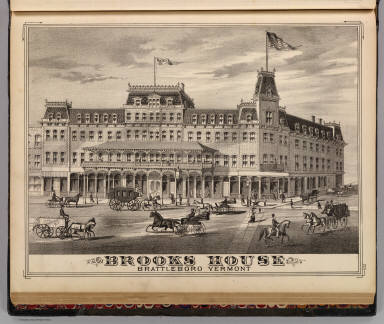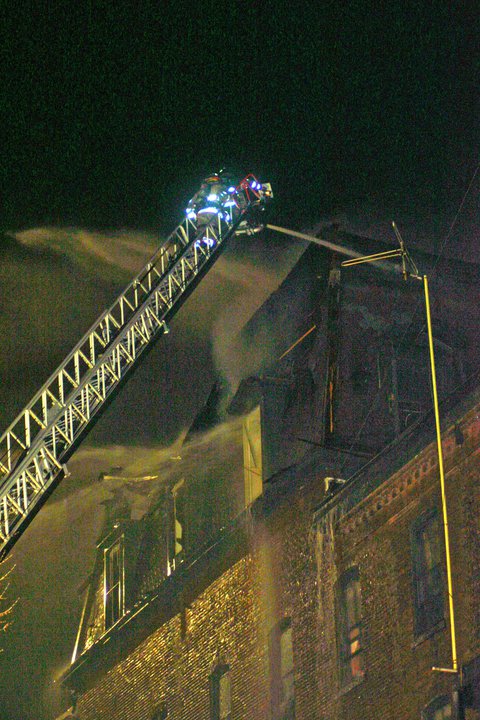In the middle ages buildings were very vulnerable for fires. They adapted the constructions in such a way that they still would burn down (that is, the facade, roof and flooring) but would stay structurally intact (stone separating walls, held together with thick oak beams, supporting the flooring and only on the surface effected by fires). This structural base can still be found in many buildings that look to be from much later date (17 or 18 century) and are still lasting. This strategy is also not uncommon in nature (see the need for burning sequoia trees every 20 odd years to remove parasites from its bark). Building a fireproof core with a fashionable outer facade that may burn down ones in a while (hopefully when the facade becomes out of fashion), may keep a building up to date and last for much longer then just one life cycle. Would 'Design for Burning' become in fashion one day?
Blog Post
Mixed Use: Too Many Eggs in One Basket?
Fire guts half a block of a small New England town, revealing the built-in vulnerabilities of dense development.

Brattleboro, Vermont is still in shock over the sudden and complete loss of one of its Main Street buildings early yesterday morning, apparently because of an electrical fire. Brooks House, a former hotel with a distinctive mansard roof, was built in 1871 on the ashes of an even older building also destroyed by fire. It was listed on the National Historic Register, but its historic status means nothing compared with its significance to our town. This is like a cigarette burn on the bodice of a silk gown.
The aesthetics are shocking, but the economics are a profound jolt. This was the pinnacle of sustainable building--mixed-use urban real estate and an adaptive reuse project housing a number of thriving retail establishments and 50 families. These business owners and residents have a long row to hoe.
The whole town has a long row to hoe. Main Street is literally shut down while structural damage to the building is assessed. The fire has completely disrupted the lives of hundreds of people who have lost their homes and jobs. If you are an advocate of multi-family housing, mixed use, and smart growth, this level of utter devastation gives you pause. Denser development means more concentrated damage. One bad wire, and poof.
When I learned that the newest Main Street business--the socially responsible bagel place--was closed, I groaned. When you walked in, you could read a long list of sustainable building strategies (including low-VOC products, FSC-certified wood, and many items crafted by local artists and artisans) the company used when renovating the interior. I don't know how damaged that particular business is (I haven't had the courage to go gawk yet), but I wonder whether all the owner's long-term thinking has gone to waste in the blink of an eye.
In our April feature on green structural engineering, we addressed the issue of building longevity and disaster resilience, and discussed whether increased durability is inherently sustainable. The up-front investment (and the higher embodied carbon sometimes associated with more durable buildings) only pays returns if these strategies actually have time to work. A fire or another disaster can take it all away like that.
SUPPORT INDEPENDENT SUSTAINABILITY REPORTING
BuildingGreen relies on our premium members, not on advertisers. Help make our work possible.
See membership options »What's more, that story did not address something that we leave out of pretty much every article here at BuildingGreen. Hopefully it is understood, but it doesn't hurt to say it out loud every once in a while. Great buildings are more to people than four walls and a roof. They are greater than the sum of their LEED credits and go deeper than their fly ash concrete foundations. Great buildings are the fabric of our communities and our economy. We also keep them in our hearts.
Making the right choices about where and how to build is a big responsibility, and every choice, it seems, involves tradeoffs. Sustainable design, by definition, plans for the long term. Most of the time, it works great--but some outcomes are out of our hands.
Published April 19, 2011 Permalink Citation
(2011, April 19). Mixed Use: Too Many Eggs in One Basket?. Retrieved from https://www.buildinggreen.com/blog/mixed-use-too-many-eggs-one-basket
Comments
The bagel place is just fine.
The bagel place is just fine. A little water damage, but open for business.
There's a flip side to the Brooks House, too: much of it is salvageable, and many of the businesses are planning to reopen. That's the durability issue you mention. Although the building was wood-framed and brick-faced, it's still structurally sound (although they were worried it wouldn't be). The local deconstruction company is taking down the penthouse and saving what they can, and the owner is planning to rebuild. A less durable building would have crumbled or have needed to be torn down.
It's also at the heart of a community that is banding together to help those affected. I'm not sure that would happen in quite the same way in a suburban strip mall. The residents are helping businesses and vice versa.
So as you say, the building is more than just a building. It's a community--and that hasn't changed.
According to the Brattleboro
According to the Brattleboro Reformer, "The Vermont State Police Fire Investigation Unit has determined the cause of the fire to be electrical in nature, ... though the apartment in which it began remains unknown."
Apparently the fire marshal and the building manager worked hard a couple years ago to bring it up to code (although one gets the sense it was just barely so). The worst part is that renovations seem to have left air spaces with no sprinkler system, where the fire kept moving around. The newspaper quoted the fire chief as saying that "It just went both ways all in that void area. It was very stubborn." Perhaps one of the lessons here is that you have to be careful with adaptive reuse.
Heartbreaking. Any word on wh
Heartbreaking.
Any word on what caused the fire?
Did the bldg have modern wiring?




Add new comment
To post a comment, you need to register for a BuildingGreen Basic membership (free) or login to your existing profile.